Part 5: Future-focused governance in practice
5.1
In this Part, we outline some observations about how Boards are financially preparing for the future. We describe what the financial statements and our survey of asset management tell us about trends in future-focused governance over time and what interviewees told us they experience when trying to earn dividends and raise capital.
5.2
Overall, we found evidence of longer-term thinking, good asset management, and reserves for addressing unexpected events. We also found a more "negotiated" dividend policy than occurs in the private sector (see paragraphs 5.19-5.24). We observed that these differences should be considered when determining expectations of Crown-owned companies.
Being able to achieve future-focused governance
5.3
The way a Crown-owned company's financial resources are organised and managed provides insights into how much emphasis there is on future-focused governance in particular, the company's capacity to manage uncertainty (or risk) and invest for the future.
Trends in managing assets
5.4
Asset management plays a significant role in ensuring that resources are able to deliver future services in a resilient and sustainable way. We recently asked the auditors of SOEs, CRIs, and other Crown companies, as well as more than 340 other public entities with physical assets of more than $2 million, to rate how well asset management was practised throughout the public sector.12 The findings were published in our discussion paper, Managing public assets. We asked our auditors to rate the following elements of managing (physical) assets on a scale from one to four:
- the quality of information ("information");
- planned maintenance and renewals ("maintenance"); and
- the current condition of assets ("condition").
5.5
Figure 5 shows some results from Managing public assets for SOEs, CRIs, other Crown companies, and the other public entities involved. The higher the score, the better asset management is in practice.
Figure 5
Managing public assets – public entities' average ratings for information, maintenance, and condition
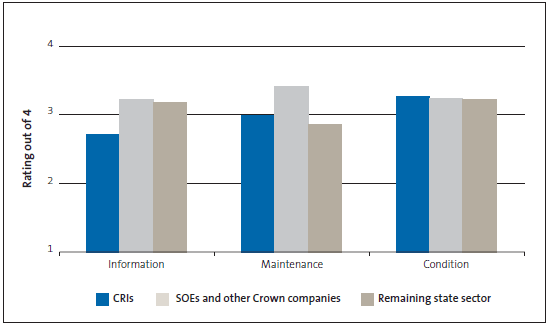
Note: For Information, a rating of four means that an entity holds enough information to ensure that all assets that provide services are kept in a condition that supports the continuing delivery of services. A rating of one means that the entity holds no such information. For Maintenance, a rating of four means that maintenance and renewal is in keeping with the plan. A rating of one means that the entity is not following a maintenance and renewal plan at all. For Condition, a rating of four means that the asset is in very good condition. A rating of one means that it is in poor condition.
5.6
The CRIs and SOEs and other Crown companies have different kinds and amounts of assets. For example, some companies have strategically significant physical assets, such as Transpower, and others have physical assets with limited monetary value, such as Crown Fibre Holdings. Others are focused on developing intellectual property, such as CRIs. Despite these differences, the commercial model assumes that private sector discipline will improve asset management practices. We noted that the averages for SOEs, CRIs, and other Crown companies were (in most instances) better than the averages for the remaining state sector entities.
5.7
Further evidence of the quality of Crown-owned companies' long-term asset management can be seen by comparing capital asset spending with what an accounting assumption suggests is reasonable (depreciation). We collected this information from the audited financial statements of each entity from 2007 to 2012.13
5.8
As Figure 6 shows, from 2007 to 2013, the average annual percentages indicate that all the categories of public entity are investing above the depreciation level.14 As a group, SOEs and other Crown companies are investing more than CRIs and the remaining state sector entities. The difference reduced between 2007 and 2012 and slightly increased in 2013.15
Figure 6
Public entities' capital expenditure compared to depreciation, 2007-2013
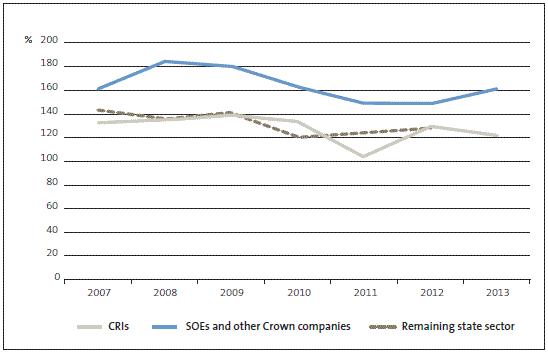
Note: Wherever possible, we have endeavoured to include 2013 data. However, there are different reporting dates for different entities. At time of publication, 2013 data for all of the remaining state sector was not available.
Being able to manage uncertainty: Flexibility and buffers against shocks
5.9
Being able to deal with the future and having options for addressing future challenges depends on many factors, including Crown-owned companies being able to reallocate financial resources and manage liabilities as they fall due.
5.10
The information in annual reports provides some evidence of how well Crown-owned companies are able to manage future challenges and uncertainties. To show this, we looked at three aspects of the financial statements:
- the proportion of fixed costs;
- the ability to meet current liabilities from available resources; and
- the ability to finance operations and investments (and deliver shareholder returns).
5.11
In general, although we found that most SOEs, CRIs, and other Crown companies have the capacity to manage future uncertainty, SOEs and other Crown companies, as a group, have been better positioned financially for achieving future-focused governance than CRIs.
The proportion of fixed costs
5.12
Fixed costs usually include full-time personnel, interest, and depreciation (as a proxy for renewal capital expenditure). To show the flexibility to respond to changing circumstances in the short term using only one indicator, we compared fixed costs to the entities' operating and investing cash outflows. A proportion of 100% means that all costs are fixed and cannot be easily changed.
5.13
As Figure 7 shows, CRIs have the least flexible cost structures, with fixed costs ranging from 59% to 63% of operating and investing cash outflows. As a group, SOEs and other Crown companies have a relatively more flexible cost structure, with lower fixed costs than the average for the remaining state sector entities.
Figure 7
Public entities' fixed costs as a percentage of operating and investing cash outflows, 2007-2013
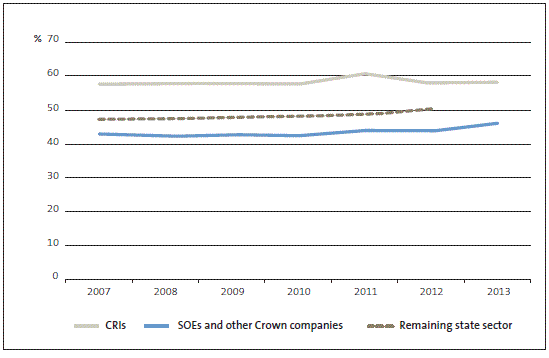
Note: Wherever possible, we have endeavoured to include 2013 data. However, there are different reporting dates for different entities. At time of publication, 2013 data for all of the remaining state sector was not available.
Being able to meet current liabilities from available resources
5.14
Being able to manage current liability obligations in times of change allows more freedom to focus on future challenges and opportunities when they arise. To show this capacity, we compared current liabilities with current assets over time. A proportion above 100% means that there are enough current assets to cover current liabilities. This indicates a greater potential to focus on the future.
5.15
From 2007 to 2012, the averages are all about or above 100%, indicating that current liabilities are reasonable and should not unduly limit how well companies respond to future uncertainties. For SOEs and the remaining state sector entities, the proportion is well above 100%. CRIs showed an increase from 97% in 2007 to 120% in 2013.
Being able to pay for operations and investments (and deliver shareholder returns)
5.16
A Crown-owned company's ability to raise finance should affect its strategy, appetite for risk, governance, and shareholders' expectations. As a group, CRIs have little debt financing. They also now have stable core funding. It remains to be seen whether this funding change will help make CRIs better able to manage uncertainty and invest for the future.
5.17
The situation for SOEs and other Crown companies is different. Interviewees had mixed views on their ability, politically and economically, to raise finance from the Government or the private sector. Figure 8 outlines SOEs' debt compared to their assets for each SOE (the square dots) from 2007 to 2013. A proportion of 0% indicates that an SOE has no debt. The range in each year is the difference between the square dots, and the average over time is represented by the dashed line starting in 2007 and ending in 2013.
Figure 8
State-owned enterprises' and other Crown companies' total debt compared to total assets, 2007-2013
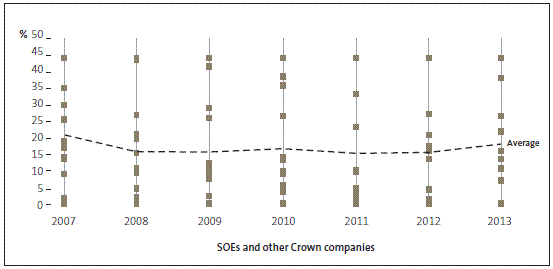
5.18
From 2007 to 2013, the average for SOEs and other Crown companies shows debt declining as a percentage of total assets from 21% in 2007 to 17% in 2012, and rising slightly in 2013 to 19%. This profile is different for entities in the private sector, where entities can have debt levels at 40%-60%, depending on their appetite for risk.16 Although this comparison implies that SOEs could have more debt, current debt may reflect a more risk-averse attitude from Boards or their shareholding Ministers. The Treasury's Long-Term Fiscal Statement advocates for overall government debt levels to be at, or below, 20%.
5.19
Some SOEs understood from their shareholding Minister that their main contribution to the public good was increasing dividends to the Government. However, the Boards of Crown-owned companies have a duty of care to ensure that the entity remains solvent after that dividend has been paid.17 Therefore, there is an inevitable trade-off between shareholder return expectations and retaining enough funds to manage future operating and investing decisions.
5.20
Some interviewees perceived that the Government had a mainly short-term focus on dividend expectations. At times, the interviewees considered that this was at the expense of current/future investments. The interviewees perceived that dividend streams were directed by the Government and affected retention of capital for investment. The interviewees thought it difficult for Crown-owned companies to raise new equity capital. Some suggested that there was a need to distinguish between the different funding requirements of mature and growing SOEs, CRIs, and other Crown companies.
5.21
In considering this, we looked at dividends paid as a proportion of the net operating cash flows available from 2007 to 2013. As Figure 9 shows, when SOEs and other Crown companies paid dividends, they were, on average, between about 30% and 60% of net operating cash flows. SOEs and other Crown companies had a higher "payout" proportion than CRIs.
Figure 9
Crown-owned companies' dividends as percentage of net operating cash flows, 2007-2013
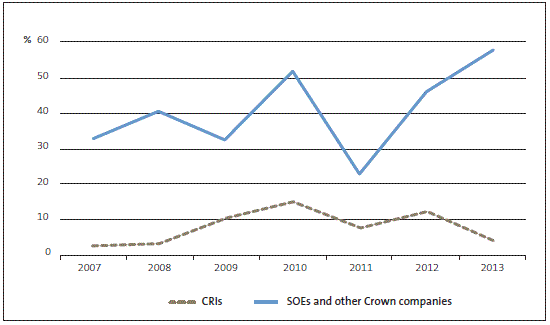
5.22
From a future-focused perspective, Figure 12 shows that, when paying dividends, SOEs and other Crown companies retain between about 40% and 70% of their net operating cash flows for their future investing and financing needs. CRIs retain about 90% to 95%. Six of the 12 SOEs and other Crown companies and four of the seven CRIs declared no dividends for three or more of the six years shown. One SOE also reinvested some or all of its declared dividends into the business from 2008 to 2011.
5.23
The variability in dividends and "payout" proportions over time could suggest that, for SOEs, CRIs, and other Crown companies, dividends are more "negotiated" than the dividends of private sector companies. For listed companies, dividends are valued as a relatively stable cash return to shareholders and any equity funding requirement is usually arranged by separately issuing additional shares.18
5.24
This could mean that Crown-owned companies and listed companies have different views on how to prepare for the future.
What we observed about Crown-owned companies' financial ability to respond to future needs
5.25
Together, our analysis of the financial statement information and our asset survey shows evidence of longer-term thinking and better asset management in Crown-owned companies than in other state sector entities. It also shows appropriate financial management. It suggests that the commercial model can help Boards to focus on the future and that Crown-owned companies are in a position to deliver future-focused governance.
12: Crown Fibre Holdings and Quotable Value were not part of the asset management survey because their physical assets are worth less than $2 million.
13: Crown Fibre Holdings Limited was set up to manage the Crown's investment in broadband infrastructure in October 2009. Its first full-year financial statements were for the year ended 30 June 2011. We have not included it in these results.
14: SOEs and other Crown companies have been grouped as one category because of the small number of other Crown companies in our study.
15: For all of the following graphs, which are based on audited financial statements, we have made judgements in collecting and analysing the data. Our aim is to identify underlying trends, rather than record the diversity of accounting policies and treatments. Therefore, we have included figures as displayed in the headline statements, even if the figures are made up of slightly different components. For example, some entities use depreciation alone in their headline statements, while others include impairments. Also, to isolate general trends, we capped extreme one-off events. For example, a one-off billion dollar cash injection because of a new project in one year of the six would distort the general trend for more usual capital expenditure and depreciation.
16: Acceptable proportions of debt to assets are disputed and depend on many things, including how asset-intensive the industry is. For example, see Cecchetti, S., Mohanty, M., and Zampolli F., (2011), "The real effects of debt", in Bank for International Settlements, Working paper No. 352, http://www.bis.org/publ/work352.htm.
17: As in section 4(1) of the Companies Act 1993.
18: Although the actual relationship between stable returns and company value may be disputed (see Gwilym, O., Morgan, G. and Thomas, S. (2000), "Dividend Stability, Dividend Yield and Stock Returns: UK Evidence", Journal of Business Finance and Accounting, 27(3) and (4), pages 261-281), many companies still try to maintain stable cash returns to signal company value and stability to the market.
page top
